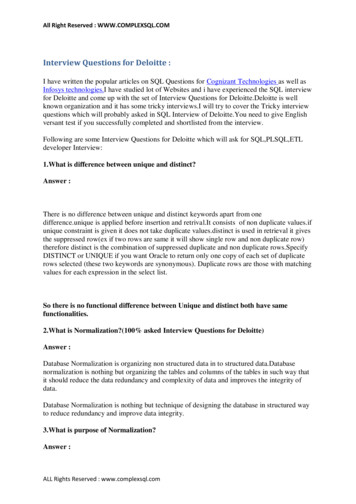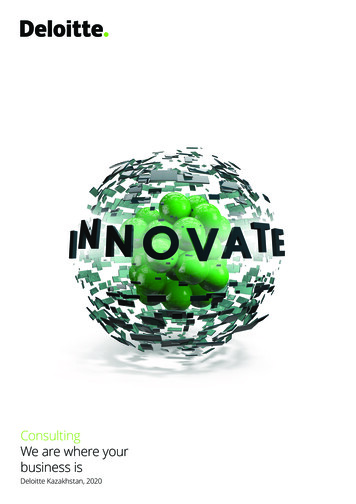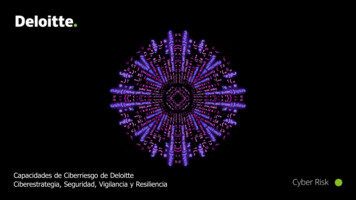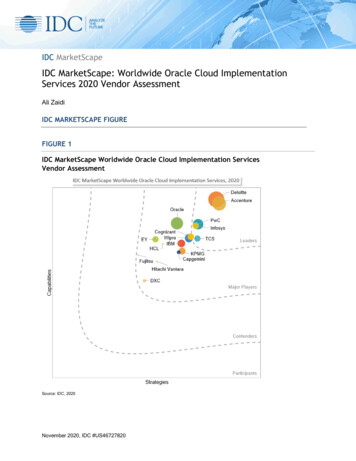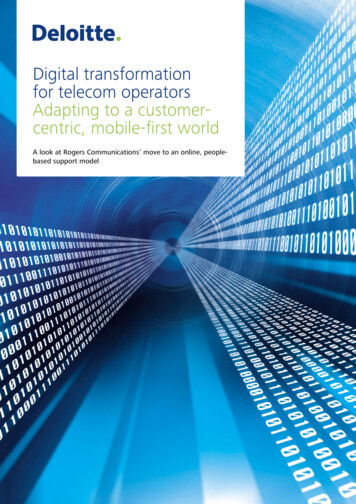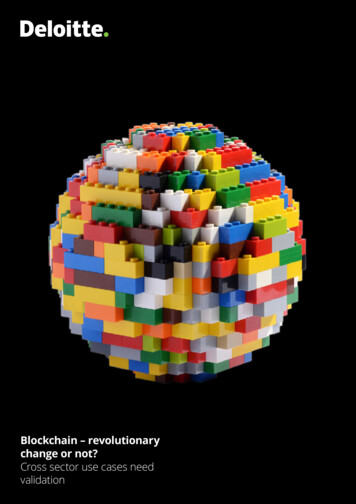
Transcription
Blockchain – revolutionarychange or not?Cross sector use cases needvalidation
Blockchain – revolutionary change or not?Introduction04What is the core technology?04When is Blockchain useful?06How “Blockchain” can impact the world02across industries?07Potential challengesto mainstream adoption10Conclusion1003
Blockchain – revolutionary change or not?Blockchain – revolutionary change or not?Blockchain01. IntroductionIf one is involved in the area of BankingTechnology, chances are that the word‘Blockchain’ no longer sounds alien,but at the same time, possibly triggersmore questions than answers. TheWorld Economic Forum estimates thatby 2017, 80% of all banks are going toinitiate projects concerning DistributedLedger Technology (DLT)—the underlyingtechnology supporting a Blockchain. In thepast three years, FinTech startups workingon Blockchain have attracted venturecapital funding of over 1.4 Billion. Allthese statistics point to the unparalleledexcitement triggered by a technologywhose first contours were defined less thana decade ago, just when the global financialservices industry faced one of its toughestchallenges in recent history.02. What is the core technology?In its simplest form, a blockchain actslike a shared, replicated, append-onlydatabase where write access is sharedamong participants but validation can beperformed by all participants in a publicblockchain.Taking the elements common to mostblockchain systems, there is: A data store, usually containing financialtransactions, but could contain any typeof data; Data replication across a number ofsystems in real-time; Peer-to-peer network topology instead ofhierarchical client-server models;04 Usage of cryptography and digitalsignatures to prove identity, authenticityand enforce read/write access rights; and Mechanisms that make it hard to changehistorical records, and make it easy todetect when someone attempts to do so.Public and private blockchain concepts andexamples:Public blockchain: A public blockchain is aplatform where anyone canread or write onthe platform, provided they can show proofof work. There has been a lot of activity inthis space as the number of potential usersthat any technology in this space couldgenerate is high. Also, a public blockchain isconsidered to be fully decentralized. Someexamples: Ethereum, a provider of a decentralizedplatform and programming languagethat helps running smart contracts andallows developers to publish distributedapplications. Factom, a provider of recordsmanagement, records businessprocesses for business and governments. Blockstream, a provider of sidechaintechnology, focused on extendingcapabilities of bitcoin. The companyhas started experimenting on providingaccounting (considered a function to bedone on private blockchain) with the useof public blockchain technology.Private blockchain: A private blockchain,on the other hand, allows only the ownerto have the rights on any changes that05
Blockchain – revolutionary change or not? Multichain, provides an open sourcedistributed database for financialtransactions. There is a need for a structured repository of information, whether the data is structured inspreadsheet-like tables or like a filling system Databases are modified via ‘transactions’ which represent a set of changes to the database which mustbe accepted or rejected as a wholeGlobal Money MovementFacilitate movement ofmoney internationally in(near) real-time with lowerfriction and costsDigital IdentityUse digital identity servicesto meet regulatory needs,prevent fraud and enhanceoverall client experience There needs to be a lack of trusted intermediary, or central gatekeeper to verify n Blockchains enable databases with multiple non-trusting writers to be modified directlyRegulatory Reporting andcomplianceStore financial info to eliminate errorsassociated with manual audit activities,reduce reporting costs and, supportbroader regulatory activitiesClaims ProcessingSmart contracts deliveran improved customerexperience and lower costswith transparent & automatedclaims processingnCustomer onboardingImprove customeronboarding experienceleveraging digital identitiesover BlockchainC apital MarketsTrade SettlementDecentralized settlementof trades powered bymulti signature escrowentity allowing for fastersettlement Transactions can be independently verified and processed by every node which maintains a copy ofthe database Blockchains truly shine where there is some interaction or dependency between the transactionscreated by different writers Blockchain transactions can be created collaboratively by multiple writers, without either party exposingthemselves to riskSource: Gideon Greenspan. “Avoiding the pointless blockchainproject.” 24 November, 2015.06gin Mistrust means that one user will not accept the “truth” as reported by another userBlockchainUse Casesnk Mistrust arises between separate organizations, but can also exist within a single large organization,such as between departments or operations in different countriesIn sural Ba There needs to be a level of mistrust between the entities writing to the databaseAbsence toTrustngnk iRetPayroll DisbursementsBypass the fees and delaysassociated with internationalmoney transfersail BUnderwritingVerify identities, ensurecompletaness of applications, evaluate risksand completequoting and bindingce In most cases the writers will also run ‘nodes’ which hold a copy of the database and retay transactions toother nodes in a peer-to-peer fashion (but not required)Interbank SettlementAllows direct settlementbetween two or, morebanks using a d istributedledger (and, optionally digitalcurrency tokens)for improved efficincyLoyaltyAllow customers to earn andredeem loyalty points bothinternal and external to theorganization’s loyalty ecosystemCommerciaMultipleWriters There needs to be more than one entity which is generating the transactions that modify the databaseremittances”, “Post trade settlements”,“Trade Finance” and even “Loyaltyprograms” applications from the globalfinancial services giants.The below infographic illustrates various Blockchain use cases in Financial Services:aSharedDatabase03. When is Blockchain useful?Many companies are jumping on theBlockchainbandwagon but do not have fullyvetted use cases. Blockchainworks bestwhen allof the following conditions are met:Here is a glimpse at the gamut ofblockchain applicationsThe Financial Services industry iswitnessing an increasing number ofBlockchain-based use cases that yield thepotential to drive significant operationaland client experience improvements. Thereare multiple experiments in “Cross-bordertMa nagement Blockstack aims to provide financialinstitutions back-office operations,including clearing & settlement on aprivate blockchain.The common wider themethat runs acrossthese diverse applications and platforms isthe emergence of a new paradigm where‘trust’ will move from having to be ownedand certified by central institutions (likebanks or governments) to being actuallybased on computer science and specificallycryptography. And it will lead to us havinga peer-based way to share ownership ofdigital assets and transfer them.04. How “Blockchain” can impact theworld across industries?As we found during our research, thereis lot of press and hype around howblockchain can impact industries and thebroader society. As someone tweeted “Weneed a ledger to store all the press andhype around blockchain”.se Eris Industries aims to be the providerof shared software database usingblockchain technology. Chain Inc., a provider of blockchain APIs.Chain partnered with Nasdaq OMXGroup Inc., to provide a platform thatenables trading private company shareswith the blockchain.Ashave to be done. This could be seen as asimilar version to the existing infrastructurewherein the owner (a centralized authority)would have the power to change the rules,revert transactions, etc., based on theneed. This could be a concept with hugeinterest from FIs and large companies. Itcould find use cases to build proprietarysystems and reduce the costs while at thesame time, increase their efficiency. Someof the examples could be as follows:Blockchain – revolutionary change or not?Trade FinanceStreamline and shorten the tradefinance process, drive efficiencygains and open up new financingproduct opportunitiesSyndicated LoansAutomate syndicateformation, underwritingand disbursement of funds(e.g. principal and interestpayments) to reduce loanissuance time and ops. riskAsset Re-hypothecationTrack and manage assetre-hypothecation via smartcontracts to enable real-time enforcement of regulatorycontrol limits and reducesettlement timeSmart ‘legal ContractsSelf executable programthat enforces legalagreements without trustedintermediaries and theirassociated transaction costs07
Blockchain – revolutionary change or not?Blockchain – revolutionary change or not?Use cases in other industries such as Life Science and Healthcare are also being explored:Use CasesProviders12Life Sciences Interoperable health records Pharmaceautical supply chain Value based care calculations Pharmacy RX fulfillment Marketing expendturereporting PBM auditing Clinical trails Genomics IP & collaborationPayers Claim adjudication usingsmart contractsMed Tech Smart device connectivity Dispute managementshadowchains Provider directories43Trade Finance – Letters of credit areone of the most commonly used tradefinance instruments today and rely onhighly manual, paper-based processes.Due to extended processing time ina trade transaction, purchasers andsuppliers are not making the mostefficient use of their capital as well as theauthenticity of trade documents is requiredthroughout the process to preventfraudulent transactions.A Blockchain-based solution can capturethe details contained in a purchaseorder, bill of lading, invoice, and trackingof shipment in a smart contract on theblockchain. We created smart oracle toprovide shipping tracking information andtrigger conditions within the smart contractmechanism (e.g., smart oracles, detect apayment).Source – Deloitte ResearchGlobally, a few non-financial use cases havealso emerged to the fore. Abstracts of suchuse casesare shown below:Deloitte has developed multiple prototypesacross sectors and use cases. We havementioned a few of these use cases below:Cross-Border Payments – Cross-borderpayments volume business to businessand consumer to consumer and on therise ( 155bn market). In the current set-up,sending money across the border takes alot of time (2-7 days on average), 8%costson an average as transaction cost (11.2%with banks), the current system does notprovide the ability to share rich meta-data,and end-to-end traceability.Payments on blockchain can be quick (510 seconds), cheap (network transactioncosts near zero), data rich (enable sharingrich transaction data and sender/receiverinformation for AML checks), frictionless(paperless front-end; competitive ratesdelivered by pathfinding algorithms,great customer experience), immutable(tamper-resistant record creates a singlesource of truth for reporting), transparent(provide end-to-end visibility of fundsand ownership), and secure (protected bycryptography & multi-key authorization). Itcan also open up new business models likemicro-payments, etc.08Government of Sweden is testing asystem for registering and recordingland titles that utilizes blockchain ina bid to digitize real estate processes.Lantmäteriet, or the Swedish National LandSurvey, is working on a proof-of-conceptthat investigates how blockchain techcould reduce the risk of manual errorswhile creating more secure processes fortransferring documents.The project comes as governments aroundthe world are showing growing interest inusing blockchain technology to improvethe land registry process. In April, bitcoinmining and technology company BitFuryunveiled a pilot with the National Agency ofPublic Registry in the Republic of Georgia.iGem launches global healthcareblockchainBlockchain technology platform Gem haslaunched Gem Health, an initiative forbuilding an inclusive blockchain ecosystemfor healthcare. Gem Health endeavors toprovide the data infrastructure to supporta globally integrated healthcare continuum,said a statement. This includes acommunity-driven educational componentand plans to build a private Ethereumnetwork for developing enterprisehealthcare applications.Medical data is the lifeblood of healthcare,creating a profile for every patientthat develops in complexity and scopethroughout life. Today, medical history isfragmented and siloed, preventing doctorsand patients from building a completerecord of health. Gem believes thatblockchain networks are a scalable solutionfor shared infrastructure that keeps criticalpatient data in the right hands.In healthcare, these use cases rangefrom claims processing to genomic datamanagement, but at the core of each is theneed for data to be shared seamlessly andsecured infallibly.iiLoyalty Rewards - Loyalty rewardprograms are currently fragmented, costlyand slow. Some of the key problemsinclude: High lag between availing of service andcredit of loyalty points - customers can’tuse or even viewpoints instantly Inherent inefficiencies with the system(and high associated cost) Poor data integrity with significant threatof security and privacy abuse Usage of reward points doesn’t live up tothe potential due to limited redemptionoptionsA blockchain-based loyalty rewardsprograms can address the aboveissues. An omni-channel customerloyalty program based on multi-tokenblockchain can be configured easily (withmultiple reward types and reward rules) tonear-instantly reward points to customersupon purchase / usage of companyproducts / services. Tokens accumulatedcan then be redeemed for a variety ofreward options by adding new vendors onthe blockchain.09
Blockchain – revolutionary change or not?Blockchain applications in energytradingPicture a trade floor five years in thefuture. The robotic trader managing oneof the gas desks is about to execute aphysical natural gas trade with an industrialcustomer. One of the robot’s tradingalgorithms scans available market interestand optimizes its search for the best dealto meet the customer’s volume and tenorrequirements for a given period. Once therobot’s proposed deal terms are approvedby the customer, the trade is executedand recorded on the blockchain. The dealterms are automatically confirmed andnomination information is recorded on theblockchain and available to the pipelineshipping the gas. As gas flows throughoutthe month, physical settlement occurs dailywith payment initiated immediately. Allactivity added to the blockchain is readilyavailable to the seller, buyer, pipeline,and bank. Physical title of the gas is alsoconveyed directly via the blockchain.iii05. Potential challengesto mainstreamadoptionBlockchains are not without their hurdles.While blockchain has immense potentialto the society, it is also recognized thatthis is hard to achieve without substantialregulatory will and collaborative effort fromall parties involved. Total transparency a double-edgedsword - The demand for change inbusiness processes (transactionprocessing) will come either from thegrassroots demanding that certain datago on a blockchain and form a recordwhich cannot be subsequently edited,or from regulators and policymakersmandating such change. Requires a lot of coordination Blockchains can also be used in industryplatforms for the sharing of data that ishelpful to the industry as a whole. In thiscase, a majority of players in an industryneed to come together and agree onwhat such a platform would look like, whowould pay for it, and what value eachparticipant would get from it. Regulatory clarity over datasovereignty - Regulatory clarity of onand off-chain assets is something that isoften discussed, in the context of bitcoinsand the issues of data governance of ashare certificate on a blockchain. Whatis often neglected is regulatory clarityover data sovereignty. In an industryblockchain, the same data is copied overmany data centres, often in differentcountries. A lot of the data are encryptedso that only the intended recipient cansee it.In some industries this is fine, but infinancial services, control of data is heavilyregulated. Are banks comfortable sending,receiving, and storing data without knowingexactly what they are storing in their datacentres? Are regulators comfortable withbanks in their oversight storing unknown,encrypted data? Are banks comfortablewith their competitors storing theirdata, encrypted or otherwise? After all, ablockchain replaces a trusted third partywith a network of participants but in thecase of an industry blockchain, manyparticipants will be competitors.06. ConclusionIn many ways, Blockchain today iscomparable to where the Internet was inearly 1990s. While we have witnessed howthe ‘Internet of Information’ has changedour societies over the past two decades, weare now entering a phase where Blockchainis likely to do the same by ushering ina newparadigmcomprising ‘Internet of Trust’ and‘Internet of Value’. It is expected to disruptthe way stakeholders would interact in adecentralized framework of trust, therebyincreasingly democratizing value. Banksand financial services institutions play avery important role in those wider societalinteractions today and Blockchain istherefore forcing them to rethink their rolesto stay relevant in this emerging paradigm.It's early days, but industry leadersaresponsoring a wide range of blockchain usecases supported by industry consortiums.Having seen the potential of thistechnology and the challenges, we thinkthe opportunity is clear but the blue sky istoo far off and companies need to validateuse cases and business / technical viabilitybefore implementing blockchain.AuthorsRajarshi Senguptarsengupta@deloitte.comLakshman ids-with-blockchain-technologyiii10
Deloitte refers to one or more of Deloitte Touche Tohmatsu Limited, a UK privatecompany limited by guarantee (“DTTL”), its network of member firms, and theirrelated entities. DTTL and each of its member firms are legally separate andindependent entities. DTTL (also referred to as “Deloitte Global”) does not provideservices to clients. Please see www.deloitte.com/about for a more detaileddescription of DTTL and its member firms.This material is prepared by Deloitte Touche Tohmatsu India LLP (DTTILLP). Thismaterial (including any information contained in it) is intended to provide generalinformation on a particular subject or subjects and is not an exhaustive treatmentof such subject(s) or a substitute to obtaining professional services or advice. Thismaterial may contain information sourced from publicly available informationor other third party sources. DTTILLP does not independently verify any suchsources and is not responsible for any loss whatsoever caused due to relianceplaced on information sourced from such sources. None of DTTILLP, DeloitteTouche Tohmatsu Limited, its member firms, or their related entities (collectively,the “Deloitte Network”) is, by means of this material, rendering professional adviceor services. Without limiting the generality of this notice and terms of use, nothingin this material or information comprises legal advice or services (you shouldconsult a legal practitioner for these). This material or information is not intendedto be relied upon as the sole basis for any decision which may affect you or yourbusiness. Before making any decision or taking any action that might affect yourpersonal finances or business, you should consult a qualified professional adviser.No entity in the Deloitte Network shall be responsible for any loss whatsoeversustained by any person by reason of access to, use of or reliance on, thismaterial. By using this material or any information contained in it, the useraccepts this entire notice and terms of use. 2017 Deloitte Touche Tohmatsu India LLP. Member of Deloitte ToucheTohmatsu Limited.
options A blockchain-based loyalty rewards programs can address the above issues. An omni-channel customer loyalty program based on multi-token blockchain can be configured easily (with multiple reward types and reward rules) to near-instantly reward points to customers upon purchase / usage of company products / services. Tokens accumulated

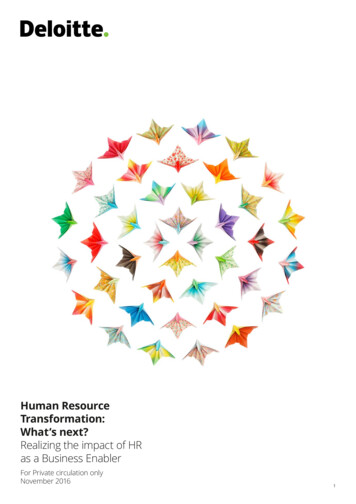
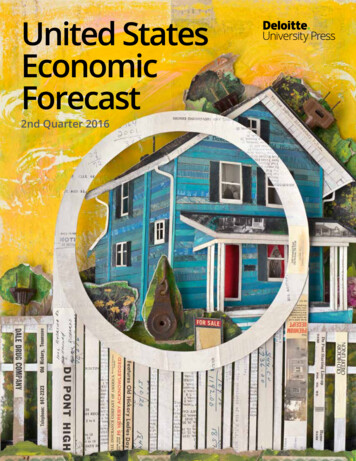

![Change Management Process For [Project Name] - West Virginia](/img/32/change-20management-20process-2003-2022-202012.jpg)
